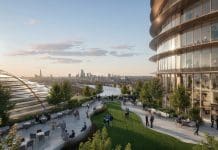Jenny Keen, planning director at Marron, explores how the UK’s growing demand for student accomodation could help- or hinder- tackling the housing crisis
With the housing crisis continuing to impact the lives of millions, the prospect of Labour’s mandatory housing targets offers promising potential for the provision of future homes in England.
However, a crucial component of the sector – student housing – has largely been overlooked in Labour’s plans, raising questions as to whether the full scope of solutions across the housing sector has truly been considered.
Demand for student housing is growing at a substantial rate
Amidst the broader landscape of the housing crisis, student housing in England faces challenges of its own. A recent report into the housing sector’s needs has predicted that the student-age population in England will grow by more than 3.4m by 2040, meaning an urgent look into how to increase provision to meet future demand is necessary.
Currently, the student accommodation market is overwhelmed by an imbalance between supply and demand, leading to a rising number of students opting for houses of multiple occupancy (HMO) over student halls. As HMOs are often created from existing housing stock, a vicious cycle is created in which students take up residences that could otherwise be used to meet the growing demand for residential homes.
The new government must incorporate this increasing demand for student accommodation into its plans to solve the housing crisis. It should set clear targets for student housing that recognise the value of high-quality, purpose-built accommodation in key locations that will ease the burden on the local residential market and free up homes of varying sizes.
However, developers should also remember that when it comes to student accommodation, one size does not fit all. Throughout the design process, multiple factors should be considered, including how the development can benefit both students and their local communities whilst simultaneously supporting the national housing targets.
Balancing national need for housing across multiple communities
This is particularly important in regions such as Southampton, which is predicted to see the greatest national increase in its 18-22 population of 32 per cent by 2040. Brighton and Hove is also expected to demonstrate a significant increase of 21 per cent. The dramatic rise in student populations isn’t just contained to the South. Home to multiple universities, Coventry is additionally set to see a 32 per cent rise, alongside regions including Leicester and Sheffield which are set to see increases of 23 per cent and 25 per cent respectively.
These figures show that the growth of the student population is a nationwide challenge that is set to grow in lockstep with the need for residential homes. If this portion of the population is not sufficiently catered for, the need for HMO accommodation will increase, removing new homes from the residential market as they are built. Because of this, the government, local authorities and developers must attempt to solve the crisis through a collaborative approach based on local need – and purpose-built student accommodation has a vital role to play.
The UK is currently the second most popular international destination to come and study, another factor that must be considered to truly understand the impact that a targeted student housing approach could have on the local area. According to the housing need report, a typical HMO houses an average of 2.5 people. By building a 1,000-bed student development, developers and local authorities could therefore quickly free up the equivalent of 400 residential homes for the community.
With such potential, it is vital that student accommodation must not become a rushed solution. To make the most of the situation and attract students to stay, it should be built with their needs and lifestyle in mind, along with a consideration of the local community. When planned well, purpose-built accommodation can offer a host of attractive benefits including increased security, higher-quality living spaces and better facilities that cater for both studying and socialising.
Developers considering diversifying into this area should adopt a data-led approach and consult with the specific universities to ensure their plans match the needs of the potential occupiers. It is important to work with the university to understand what matters most to the students, which can include factors such as location, the transport links, nearby social amenities surrounding and the internal layouts.
An example of this balancing act can be found in Nottingham Trent University’s campus accommodation. Offering both city accommodation a short walk from Nottingham’s bustling centre and nightlife, along with accommodation on the Clifton campus, the university provides its students with options when it comes to selecting accommodation that matches their lifestyles. With a tram running to the city centre, students can experience the best of both campus and city living throughout their time at the university.
Mixed-use sites reduce the risk of dead zones
While developers should work with universities to gather data to understand student requirements, they should also seek to build and maintain a strong relationship with the institution throughout the entire process. This will not only help them to tailor plans but will also allow them to remain current, keep the students informed of the new accommodation options that will be available and help to prevent an imbalance in the types of accommodation and facilities that are ultimately provided.
For example, it may be assumed that student accommodation should be clustered in one place for access to amenities and to minimise nuisance to the wider community, such as late-night noise. However, this may not be the case. When term ends, many students return to their hometowns, meaning that clustered amenities could see a significant drop in income that causes them to struggle until the new term begins.
To lower this risk, a balance of housing types should coexist in one area. Family homes, for example, could be built on the same complex, but positioned in a way that minimises nuisance. Other types of build-to-rent-housing could also be incorporated into the development plans, allowing a broader range of residents to benefit from amenities and local services outside of university term times.
Engaging regularly and closely with local authorities and the surrounding community is an essential step in forming development plans, and can help avoid backlash when submitting applications. Developers should engage with communities at the earliest possible stage, even prior to submitting applications, and arrange for in-person meetings or consultations to ensure the community has an opportunity to raise issues and receive considered and comprehensive answers.
This will help to build trust between the developers and the local community, and should include the transparent sharing of management plans that cover a range of potential issues such as maintenance, designated timing slots and drop-off zones for move-in dates and specialist design features such as sound-proofing to minimise noise. By communicating these essential elements at an early stage, developers can mitigate potential negative impacts to local residents and prevent backlash to applications – leading to a faster and smoother approval process.
Purpose-built, high quality student accommodation could be the potential catalyst that alleviates the housing crisis, at least in part. Developers must therefore work together with universities, the local authority and the wider community and adopt a data-led approach to achieve success.
As students begin to opt for purpose-built accommodation over HMOs as a matter of course, a huge number of residential homes could quickly return to the market, helping families and other prospective buyers who may otherwise struggle to find suitable, long-term housing in their local area.








![[VIDEO] Local planning inspector recruitment to begin in earnest in new year A drive to recruit local planning inspectors will begin in the new year](https://www.pbctoday.co.uk/news/wp-content/uploads/2025/12/iStock-2159482095-2-218x150.jpg)



![[VIDEO]Government launches new online appeal service for local planning authorities Group of young coworkers using computers in their group office, representing the new online appeals service](https://www.pbctoday.co.uk/news/wp-content/uploads/2025/12/iStock-2191280160-218x150.jpg)

